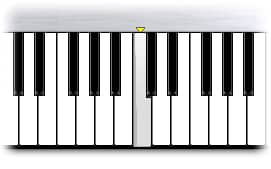(For instructions on accessing custom activities, see this page.)
Practica Musica will display several measures of notation, with a blue arrow pointing down to the first note. “Play” that note (using one of the three techniques listed below) to get the arrow to move to the next note on the staff—then continue until you reach the end of the exercise. Rhythm and timing don’t count at all, so take your time and make sure you’ve identified the correct letter name and the correct octave (i.e., where the note is in relation to middle C) before entering the pitch!
You have three options for entering pitches:
- Use an external keyboard you’ve connected to your computer with a MIDI interface. (I use a Roland UM-ONE, but check with a salesperson for help in finding a good interface to connect your computer to your keyboard.)
- Click the keys on the on-screen piano keyboard.
- Play the letter keys of the computer as a ‘piano,’ using the following keymap:

Note that you must play each note in the correct octave; e.g., middle C is different from the C on the third space of the treble clef. The on-screen keyboard will indicate which key you are playing; middle C is marked with a yellow triangle, seen below. (If you don’t see the yellow triangle, try selecting a different Keyframe appearance in the “Options” menu.)
As you progress through this exercise, you will reach levels of increasing difficulty:
- Level 1 tests only the five diatonic notes (white keys) in Right Hand C Position.
- Level 2 tests all diatonic notes between middle C and the top line of the treble clef.
- Level 3 tests all diatonic notes between 2 ledger lines below and 2 ledger lines above the treble clef.
- Level 4 tests the same notes as Level 3, but adds key signatures of up to 5 sharps or flats. (In other words, some answers in Level 4 will be black keys.)

